Lifting the Lid on Special Container Changes
- Posted:
- Written by:
- Categories:

Update: This blog was updated on 24th October 2023 with a new section “What should a practice do” after an eagle-eyed reader got in touch to highlight the discrepancies in shelf lives between manufacturers.
In this blog, one of our pharmacists, Chris Wood, describes how he used OpenPrescribing tools to help identify and investigate a sudden £450k per month increase in NHS expenditure on colesevelam tablets, a drug used to treat high cholesterol, following a small reasonable change to the NHS Drug Tariff.
Spotting a change using OpenPrescribing measures
After each monthly prescribing data update, the clinical informatics team at the Bennett Institute carefully review the standard measures within OpenPrescribing to ensure the measures have updated as expected and to look out for any unexpected trends.
OpenPrescribing has almost 100 measures of prescribing covering areas of cost effectiveness, clinical effectiveness and safety. The measures are carefully constructed by our clinical informatics team prioritising areas of national focus and all measures are intelligently prioritised in order of where there is most room for improvement for the particular organisation you are interested in. We have dashboards for every single practice, PCN, ICB, NHS England region and indeed the entirety of England.
Sudden changes in measures can represent a shift in national guidance, systematic improvement activities by a single organisation, changes in medication price, or various other issues. Recently we spotted a sudden change in one of our long standing measures “Other lipid-modifying drugs” with a fairly sudden increase in spend occurring from April 2023, eventually levelling out at a new, higher than average, monthly spend.
This change represented an increase of £450k across England but the cause of the change was not immediately apparent to us, so we set out to investigate using the various tools in OpenPrescribing.
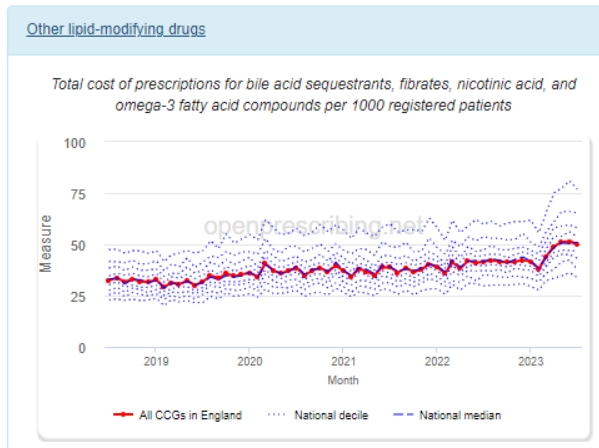
What’s going on?
First we use the additional information presented on the measures page. Looking at the “Presentations contributing to variation” table it is easy to identify colesevelam as the biggest contributor to this measure so that seems a reasonable place to start investigating.
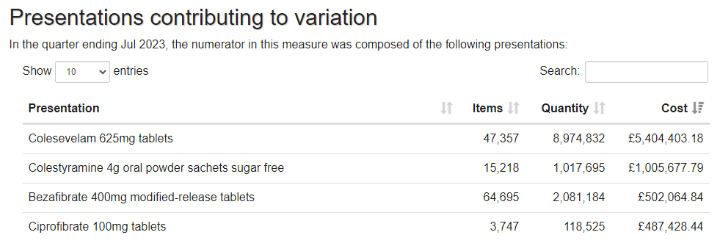
Identifying trends
Our trends for chemicals tool can help us see that for colesevelam 625mg tablets, total items (aka prescriptions) are fairly unchanged with 17,300 items in March 2023 and 16,232 items in April 2023. But, switching to the “Spending” tab, it also confirms that there was a sudden increase in spend from £1.41m in March 2023 to £1.86m in April 2023, a 32% increase.
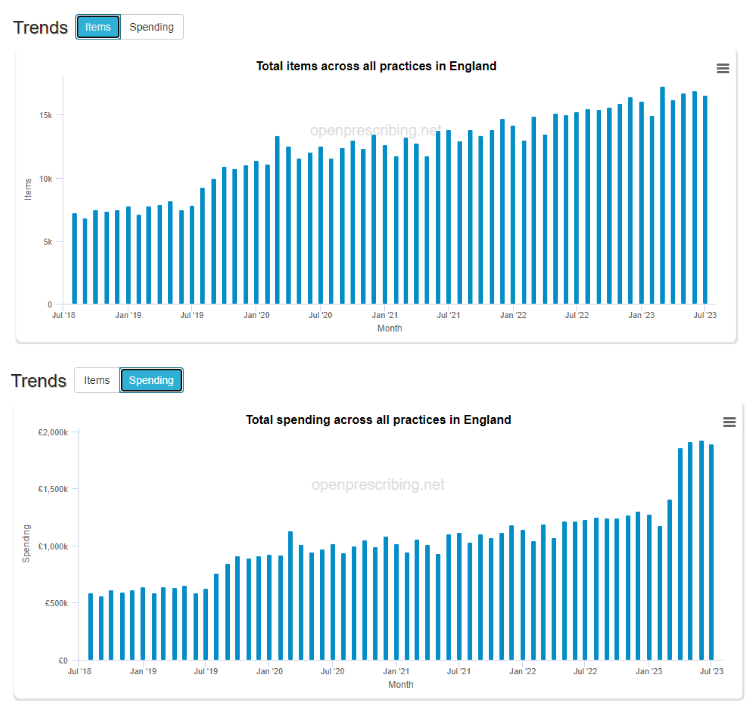
Looking for Price Changes
An increase in expenditure without a corresponding increase in items prescribed usually points towards an increase in the price paid for each item. There are two main reasons we see this occur.
Firstly, a change in the Drug Tariff price: the Drug Tariff sets out the prices that pharmacies will be reimbursed for items dispensed. Prices in the Drug Tariff can change over time (both up and down) to account for changes in what it costs for pharmacies to obtain these items. These tend to be long lasting changes in price.
Secondly, price concessions: price concessions are a short term agreement by the NHS to pay more than the already agreed price for a generic medicine because pharmacists are unable to obtain the generic at its usual price. These are usually in place for only a couple of months at most.
Using our trends for drug tariff and concessions we can see this hasn’t been subject to a price concession and the last price increase was in July 2017.
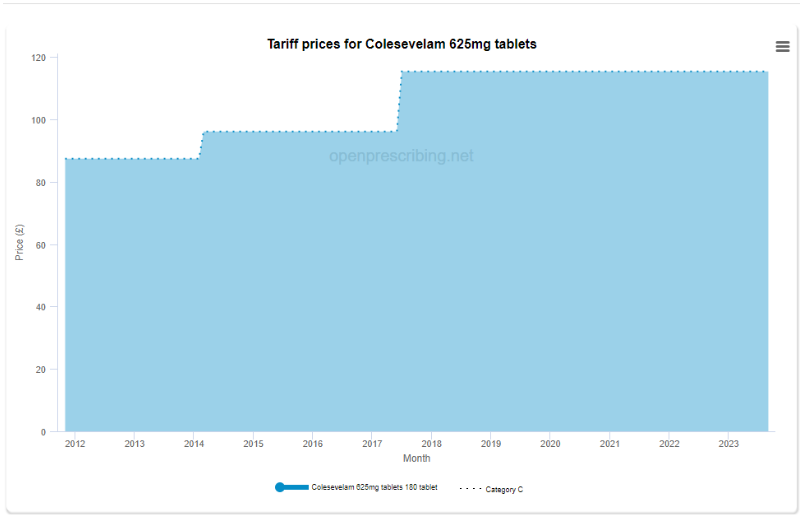
What next?
At this point we need to use some more tools and resources that are available, but only used by more advanced OpenPrescribing users, to progress the investigation. You may find the rest of the blog useful if you’d like to start using these tools and also find out the reason for the £450k increase!
OpenPrescribing API
To drill into the data further we can turn to the OpenPrescribing API. This is a tool for downloading more detailed data than is otherwise available on the site, and you can find it under the “more” menu (API stands for Application Programming Interface). We can use the spend by code API to get a monthly breakdown for colesevelam including items, quantity and spend. Here we can identify a sudden increase in the quantities of colesevelam per month from 2.3m tablets in March 2023 to 3.1m tablets in April 2023.
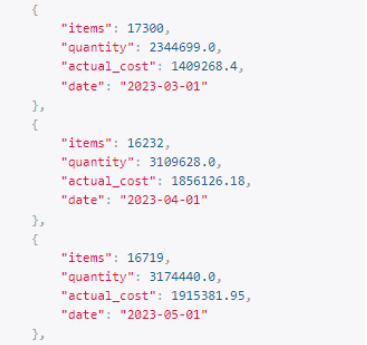
This leaves us with a new problem to solve. Why would there be a sudden increase in the number of tablets without a corresponding increase in the number of items?
External resources
Next we turn to the Drug Tariff itself. In addition to detailing reimbursement prices for pharmacies it provides other important specifics that need to be considered when dispensing medications. As the changes all seem to have occurred in April 2023, the list of changes in the April 2023 Drug Tariff is a sensible place to start. Here we can see there has been a change, the addition of a black square symbol, the rest of the information - pack size 180 tablets, reimbursement price 11532p (£115.32), and drug tariff category (category C) - remains unchanged.

Thankfully the Drug Tariff also contains a key to the symbols used. We can see here that the black square signifies special container status.
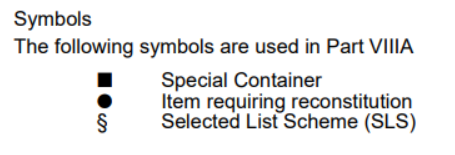
This signifies a product where it is not appropriate to split a full pack. In the case of colesevelam this is because the container is designed to prevent the tablets from absorbing water from the atmosphere. For drugs which have special container status, where the quantity ordered by the prescriber is less than the actual pack size the pharmacist will supply (and be reimbursed for) a full pack.
Digging deeper into the data
Digging into the raw data we hold on our back end systems we can find more information on the quantities per item. In March 2023 there were 10,067 part packs of colesevelam accounting for 58% of the total prescriptions that month. In April 2023 this dramatically dropped to just 3 part packs (0.02% of prescriptions).
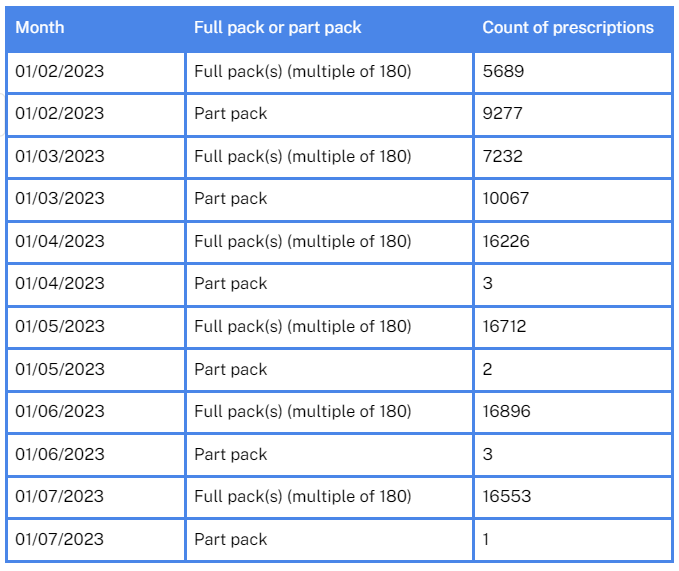
Implications
The information we have indicates that on average, each patient is receiving an increased quantity of colesevelam per prescription. A tiny important detail to remember is that OpenPrescribing runs on dispensing data that is openly published by the NHS. In most cases prescription and dispensing data are the same but in this case the change in part pack reflects a change in dispensing and it is likely that the prescriptions from GPs remain the same.
This mismatch between the prescribed and dispensed quantities can lead to confusion about when colesevelam is next due to be ordered, since the electronic health records in GP practice may show that colesevelam is due for resupply sooner than the patient actually runs out of tablets.
What should a practice do?
We aren’t sure. Practices and NHS Medicines Optimisation teams could consider reviewing patients prescribed colesevelam to ensure their prescribed quantity and the frequency at which prescriptions are reordered is optimised according to their dosage.
However, this is complicated by the fact that the shelf life of colesevelam after opening the container can be as low as 30 days (Dr Reddy’s Laboratories), or as long as two years (Glenmark Pharmaceuticals, Cholestagel®) according to the product literature. So, where the prescribed dosage is low (e.g. two tablets per day) the patient would run out of ‘in-date’ stock after 30 days and surplus stock would be wasted unless they receive a brand with a longer shelf life. Unfortunately we can’t see data on which manufacturer’s product was dispensed, so we don’t know what proportion are dispensed with the 30 day shelf life after opening and we know that most practices write these prescriptions generically so are likely to be unaware what manufacturer’s product a pharmacy is dispensing.
Get in touch!
We hope you enjoyed this description of how we spotted and got to the bottom of why the NHS is now spending an extra £450k per month on medications used to treat high cholesterol. We think it’s a good illustration of the value of clinicians, researchers, and software engineers pooling skills and knowledge to build tools that help us monitor NHS prescribing. We are certain other teams have spotted this issue and thought about it. If you have any further insights please get in touch at bennett@phc.ox.ac.uk.


